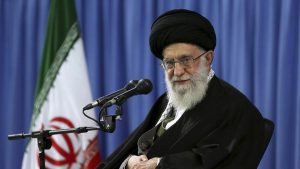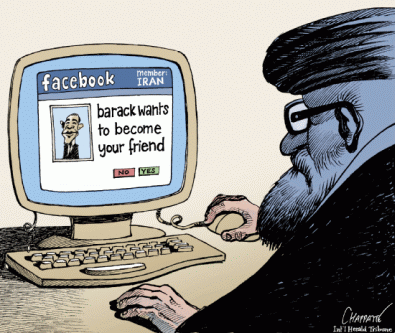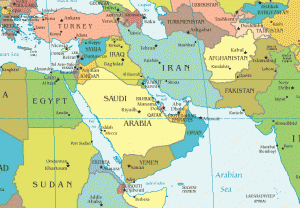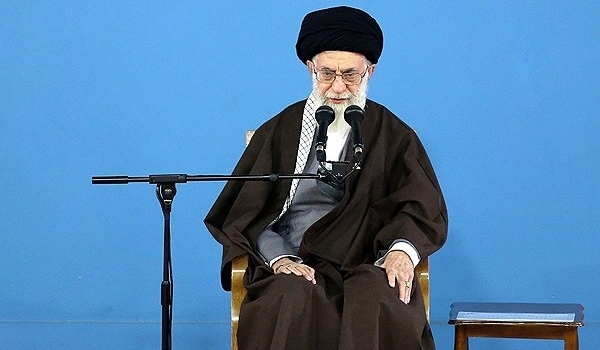It is time for a shift in U.S. policy towards Iran. We are not referring simply to the Iranian nuclear agreement, the subject of controversy and continuing debate. More importantly, America’s strategic Iranian policy requires a reorientation in order to reassert and defend American (and allied) interests in the Middle East.
U.S. Policy Towards Iran – President Obama’s Strategic Approach
Before addressing a new American policy, President Obama’s approach must be understood. There were two key components of President Obama’s Iranian strategy. We take a brief look at both.
U.S. Policy Towards Iran – Reconciliation
The first prong of Obama’s program consisted of a reconciliation between the United States and Iran. Some have labelled this as a more pragmatic approach than was taken by previous American presidents. Of course that analysis suggests President Obama was more realistic about Iran than his predecessors. But President Obama’s actions suggest otherwise.

As President Obama said in his first inaugural address, “We will extend a hand if you are willing to unclench your fist.” The first step in his reconciliation was to craft a nuclear agreement that was acceptable to Iran. As a result, this nuclear agreement would become the cornerstone of a larger accommodation whereby (it was hoped) Iran would accept, and promote, the status quo in the region. As President Obama said:
If we were able to get Iran to operate in a responsible fashion – not funding terrorist organizations, not trying to stir up sectarian discontent in other countries, and not developing a nuclear weapon – you could see an equilibrium developing between Sunni, or predominantly Sunni, Gulf states and Iran in which there’s competition, perhaps suspicion, but not an active or proxy warfare.

Flaws in the Reconciliation/Accommodation Approach
The key assumption in this approach was that a reconciliation would lead Iran to fundamentally alter its previous longer-term ambitions. This assumption could only be correct if Iran’s ambitions were premised upon, or in response to, American behavior. This presumption seems flawed.
An accommodation approach similarly presumes that the strategic interests of the United States (and, arguably, its allies) and Iran do not conflict. From the U.S. perspective, it presumed that the United States did not have a strategic concern with Iran, or within Iran’s geographic neighborhood, beyond eliminating Iran as a nuclear threat to America. This singular focus sublimates the security interests of America’s allies to those of the United States. A U.S. strategic accommodation with Iran, as a result, runs the serious risk of actually increasing instability in the region.
Iranian Behavior Has Not Changed

Subsequent Iranian actions suggest that the nuclear agreement has not altered Iranian goals. Iranian behavior pre-agreement continues unchanged post-agreement. For one, the U.S. State Department, in its report for 2015, continued to label Iran as the leading state sponsor of terrorism in the world. Further, the report noted that Iran “remained the foremost state sponsor of terrorism in 2015, providing a range of support, including financial, training, and equipment, to groups around the world.”
In addition, Iran, along with Russia, actively supported Syrian President Bashar al-Assad, who has re-assumed control of Syria. Iran bears a significant part of the blame and responsibility for the Syrian humanitarian disaster. Iran sponsorship of Hezbollah and other groups continues unabated.
U.S. Policy Towards Iran – Avoid Confrontation
The second key component in President Obama’s approach was to avoid confrontation with Iran. This prong of the U.S. policy towards Iran was marked by American withdrawal from the Syrian conflict and a reduction in American involvement in Iraq.
In the larger context, President Obama pursued a policy of American retrenchment marked by a scaling down of an American presence in the Middle East. Obama’s philosophy consisted of utilizing a multilateral approach to problem solving without a large deployment of American troops. In addition, American military power, when utilized, largely consisted of air power (bombing and drone attacks) combined with the use of local ground forces.
This approach was characterized by a reluctance to compete with Iran. As with the idea of reconciliation, confrontation avoidance weakens the perception of American commitment to its regional allies. America’s predictability, from their perspective, became less certain.
U.S. Policy Towards Iran – The Future
We can hope for a “new global architecture that could help nations come together as partners to solve shared problems.” But we live in an era marked by levels and means of competition that are more complex and nuanced than at any prior time. The world is a very different place now than it was in 1970. Yet, America’s most formidable contestants remain Russia and China. Where does Iran fit in?
Iran is Winning the Game
U.S. pursuit of a “grand agreement” policy with Iran was based on assumptions that were wrong. The implementation of this policy has come at a high cost. Iran’s nuclear ambitions are postponed for (at most) 15 years. But that is a brief second on the clock of history.
Iran has a natural advantage in playing its long-game against the United States and its democratic allies. Iran is a repressive, theocratic regime that borders on an autocracy. When the regime was challenged domestically it destroyed its opposition. Iran’s leaders are strategically shrewd. Iran plays its pieces on the world chessboard through proxies, while remaining committed to its longer-term goals of regional hegemony, the destruction of Israel and more.
Iran sits atop vast energy resources. It is a poised to be a rising economic power whose large market is attractive for western interests. Iran utilizes the West’s economic yearnings to its advantage. By simply deferring its nuclear ambitions for a short period of years, Iran has found a way to prompt the West to both lift sanctions and actively further Iran’s economic development. It has done so without compromising its military ambitions. It’s approach has been crafty and well-executed.
U.S. Policy Objectives Must Be Clarified
We suggest that the core objective of U.S. policy towards Iran remains unclear. It must be clarified. Does the United States want to see regime change in Iran? Certain actions over the Obama years suggest so, including at least rhetorical support for the Green Revolution. Or, does the U.S. want to establish a friendly relationship with the current regime, as also suggested by President Obama’s actions?
U.S. policy towards Iran begins by answering a threshold question. Is the current Iranian regime an existential threat to the United States? It is easy to default to a “yes” answer because of Iran’s apparent nuclear ambitions. But we believe the answer is a bit more nuanced. For all of its huff and bluster, Iran’s leaders have taken no action that has risked Iranian annihilation. In that limited respect, Iran’s leaders have been rational. The United States might appear to be “safe” from this perspective in the shorter term, as any Iranian attack on the U.S. would clearly be suicidal. But over the longer term safety from an existential threat becomes unclear. A future Middle Eastern world with a nuclear-armed Iran having hegemonic control over a majority of oil fields may be one where Iran is far more emboldened.
Iran Threatens U.S. Allies
But is Iran currently, or soon-to-be, an existential threat to U.S. allies? We believe this answer is an unambiguous “yes.” Iran’s threats and challenges to America’s regional allies has, and continues to be, clear. A nuclear-armed Iran may (or may not) be unlikely to use those weapons to attack an American ally – that would also run the risk of suicide. But a nuclear-armed Iran will be better positioned to take other actions that could further threaten American allies. Iran will be in a stronger position to execute on its intentions, and could thereby lead to a conventional war.
The analysis does not end with understanding Iran’s nuclear ambitions. Iran’s stated policy to destroy Israel, its antagonism to Saudi Arabia, and its destabilizing actions in Iraq, among others, each directly threaten America’s allies. The United States must protect these allies. And America’s commitment to their security must be unambiguous. A mixed American message regarding America’s Iranian objectives compromises the sanctity of that security commitment.
The United States must coldly examine the nature of the Iranian regime and its longer-term ambitions. It must do so without looking through rose-colored glasses. It must do so without ignoring what it doesn’t like to see. The United States must not repeat history’s mistake of wishing for a world that does not yet exist.
U.S. Policy towards Iran Must Incorporate the Needs of U.S. Allies
The United States cannot and should not pursue a policy with Iran that fails to fully account for the strategic needs of its regional allies. Failing to do so will ultimately either draw the U.S. into future conflicts, or force those allies to re-think their U.S. relationship as a matter of self-preservation. The U.S. policy towards Iran must incorporate these needs.
If the United States wishes to engage Iran, the U.S. must make it clear that it is unwilling to jeopardize its relationships with its allies. It must also be clear that it is not willing to sacrifice its own interests in the name of accommodation.
Containment
We believe U.S. policy towards Iran should be marked by containment. If Iran’s leaders desire broader inclusion in the world community, then the world community should expect Iran to respect the rights of its neighbors. Iran has been unwilling to do so. A nation with aggressive ambitions that threatens the existence of American allies must be contained. That is the foundation of any American security commitment to its allies. Greater clarity and commitment by America to execute on that promise creates greater security in the region as a whole.
The United States surrendered too much, too soon in the recent nuclear agreement. In the face of crippling sanctions, it managed only to get Iran to delay its nuclear program for a period of years – it failed to get a permanent renouncement. The U.S. failed to get Iran to terminate its missile development program. The U.S. also failed to get Iran to alter its regional ambitions, cease its support of terrorism, or renounce its threats to Israel. Iran gained significant economic access to Western interests. The U.S. claims it received breathing room in slowing down the Iranian nuclear program. Yet, Iran gained much breathing room to revitalize its economy and place it on a stronger footing to promote its antagonistic interests going forward. And 15 years is a very short period of time.
Is it possible for the United States to either push or entice Iran to surrender its regional ambitions that threaten U.S. allies? We think that possibility with the current regime is remote. However, it does not necessarily follow that the United States should pursue a complex and perhaps dangerous policy of regime change. Indeed, a continuation of harsh economic sanctions was likely the best available tool to promote that outcome. The U.S. permitted the Iranians to deftly eliminate that tool at the nuclear negotiations table. It will be very difficult for the U.S. to get it back. The U.S. must re-think how, if at all, it would promote a new regime in Iran.
Areas for cooperation with Iran are limited given Iran’s current ambitions. The United States should engage Iran only when engagement directly promotes America’s and its allies interests. This will likely continue to focus on the free flow of oil and a defeat of ISIS.
Increased Military Presence
America and its allies are safest when they are strongest. President Obama drew down the American military presence in the middle east. Beyond that, America has reduced its overall military commitment. Many observers believe this draw down prompted the birth and growth of ISIS. President Trump shares that view.
Former Polish foreign minister Radek Sikorski once offered a simple observation. “Everyone agrees that countries that have U.S. soldiers on their territory do not get invaded.” In his parting days, President Obama sent 3,000 U.S. troops to Poland under a NATO banner. The message was received by Russia.
The United States will need to find a way to re-insert a continuing physical presence in the middle east beyond its naval forces. Ongoing challenges from ISIS should provide the U.S. with the necessary cover to do so. But outside of Iraq, significant challenges exist in developing that U.S. physical presence.
Military conflict with Iran is not the objective. Indeed, U.S. policy towards Iran should attempt to avoid a direct military conflict. But we suggest that an American military presence beyond naval patrols is far more likely to deter a military conflict than promote one. The sooner the U.S. does so, the safer it and its allies will be.
Enforcing the Nuclear Accord
Further, U.S. commitment to its regional interests will be clearer if the U.S. insists on a no-violation approach to the nuclear agreement. The U.S. must hold Iran strictly accountable for every Iranian violation of prior agreements. This includes, but is not limited to, full accountability for violations of the nuclear agreement. To date, the U.S. has apparently shied away from highlighting possible violations.
Accountability should include comparably smaller violations, such as Iran’s violation of its heavy water obligations. It would also include Iranian attempts to acquire tons of controlled carbon fiber, pointed out by the Institute for Science and International Security in July, 2016. As they noted, even though Iran:
had enough carbon fiber to replace existing advanced centrifuge rotors and had no need for additional quantities over the next several years, let alone for tons of carbon fiber [they attempted to acquire the carbon fiber]. This attempt thus raises concerns over whether Iran intends to abide by [the nuclear agreement]. In particular, Iran may seek to stockpile the carbon fiber so as to be able to build advanced centrifuge rotors far beyond its current needs under [the agreement], providing an advantage that would allow it to quickly build an advanced centrifuge enrichment plant if it chose to leave or disregard the [agreement] during the next few years.
The nuclear agreement required Iran to notify the international community of this effort. It is required to seek United Nations Security Council permission for the purchase of direct nuclear use goods. It failed to do so.
Accountability should also include Iranian violations of United Nations resolutions. Of particular concern is Iran’s on-going missile program. Even U.N. Secretary General Ban Ki-moon has noted that Iran’s missile program is “not consistent with the constructive spirit” of the nuclear accord. Iran’s missile program should be met by the West enhancing its missile defense capabilities in the region and with its allies.
Conclusion
Renegotiation of the nuclear accord is a subject matter requiring a more detailed analysis. But one thing seems clear. The United States should not feel compelled by internal political considerations to pursue an accommodative policy with Iran. The United States must re-orient its approach to Iran. An element of realpolitik is now necessary.

